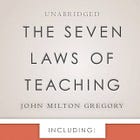As an Amazon Associate I earn from qualifying purchases
Gerth, Mandi. Thoroughness and Charm: Cultivating the Habits of a Classical Classroom. Circe, 2025
In the spirit of John Milton Gregory’s The Seven Laws of Teaching and Daniel Coupland’s Tried & True, Mandi Gerth’s new book Thoroughness & Charm serves as a brief, accessible, and (dare I say) charming primer to the basic principles of running a successful classroom. Relative to these two other works, though, Gerth emphasizes classroom practices that form teachers and cultivate a distinctly classical Christian ethos. In this way, Thoroughness & Charm aims at nothing less than joining that venerable canon of books that classical Christian schools require their new teachers to read (and veteran teachers to review on a regular basis).
Gerth begins her book with a focus on classroom management as the sine qua non of classical Christian teaching. As Gerth puts it, “But the cold, hard truth of teaching is that we are completely ineffective, no matter how passionate we are, if we can’t manage the classroom” (5). As a principal, I am continually looking for opportunities to drill this point home with new teachers, and so I heartily welcome Gerth’s emphasis on the need for the teacher to embrace being the “monarch” of the classroom, who “embodies firmness and command” (15). As veteran educators know, it is very often those teachers who seem a little bit “mean” at the start of the year that are often the most beloved teachers by the year’s end. May their tribe increase.
With classroom management in place, the teacher is then free to focus on her primary task: the work of enculturation, which Gerth defines as “transmitting a culture from one group of people to another, usually from one generation to the next” (19). Gerth reminds teachers that the classical tradition has always maintained that truth, goodness, and beauty are transcendentals that exist outside of our own minds, and therefore we are in the business of shaping children’s affections according to the Western tradition that we have inherited. Insightfully, Gerth calls us to a posture of humility before the tradition. As she suggests, “When you struggle with a text, assume the problem is you” (28). The exact scope of what Gerth understands as the “Western tradition” is, regrettably, somewhat underdetermined, though her overall point stands clearly enough.
How, though, do we go about this business of enculturation? Gerth suggests that the work of forming the imagination is central for this task. For Gerth, training students to “read mythologically” enables culture to be passed on insofar as they cultivate their moral imagination for how to live and how to understand their place in the world. As Gerth explains, “Our stories teach us how to see, what to love, and how to behave. The characters we admire, why we admire them, the choices they make, and the consequences of those choices reinforce metaphors that give meaning to our everyday experiences” (34). In guiding students through such conversations, teachers have opportunities to order the students’ loves in line with God’s revealed truth, goodness, and beauty.
Accomplishing this task requires teachers to first order their own affections, and thereby embody the tradition they seek to transmit. As Gerth exhorts teachers, “Because your attitudes and affections give your curriculum its life, you must develop an affection for your curriculum and have a positive attitude toward it” (49). The teacher, then, functions (among other metaphors) as a hostess presiding over a banquet, inviting his students to meet a variety of guests from the Great Tradition and organizing the event so everyone has what they need and knows what is expected of them. Gerth recognizes that such an approach is inherently counter-cultural. As Gerth explains, “To maintain that [Western] culture, we critique much of what contemporary society calls beautiful and oppose most of what it deems good. We pass on our inherited classical culture so that students are not enslaved to themselves or to the world” (56). Given the significance of this point, and disagreement within the movement about exactly what form such critique should take, Gerth would have done well to expand a bit more here.
In the final chapter of the book, Gerth arrives at her central contribution in this book. Drawing especially on Joshua Gibbs and James K. A. Smith, Gerth encourages teachers to develop repeated, embodied practices (“liturgies”) that drive classroom culture, form a particular understanding of reality, and point back to the big questions and ideas that frame classical Christian paideia. For Gerth, “Creating liturgical classrooms means we take seriously the place of ceremony and repetition as a way of transforming the ordinary, imbuing it with transcendent meaning” (69-70). This section is the strongest part of Gerth’s book, as she provides examples from her own teaching career of liturgies involving historical prayers, hymns, poetry, reading aloud, and catechisms that she seamlessly integrated into her classrooms. The extensive appendices to the book provide cultivated lists and further examples that will make it easy for a teacher to incorporate these ideas into their own classrooms.
While the book’s warm, conversational tone makes for an easily digestible book (something that busy, stressed teachers always appreciate), Thoroughness & Charm would benefit from a tighter organization; the logical flow between and within chapters is sometimes difficult to follow. Additionally, in light of the book’s heavy reliance on Gibbs and Smith, Gerth would benefit from bringing in a greater diversity of writers and thinkers who could help flesh out additional nuance and provide additional perspective. Still, there is no question that Mandi Gerth has provided a practical, winsome resource that will help advance the mission of classical Christian education. Whether as an assigned book for new teachers or as a text to be studied over a series of staff meetings, Thoroughness & Charm should be a staple resource for teachers in every classical Christian school. Gerth’s book will be joining my school’s canon of essential texts for teachers to read, and I hope that it will find a similar place at your school as well.
Kyle R. Hughes is a scholar-pastor-teacher specializing in the study of early Christianity and working to mine the riches of patristic theology for the modern church and for Christian schools. Kyle’s primary theological interests include the development of the doctrine of the Holy Spirit, spiritual formation in the Anglican tradition, and Christian teaching and learning. He is the author of several books, including Teaching for Spiritual Formation: A Patristic Approach to Christian Education in a Convulsed Age (Cascade, 2022). Follow him at www.kylerhughes.com or on Twitter/X @KyleRHughes10.





